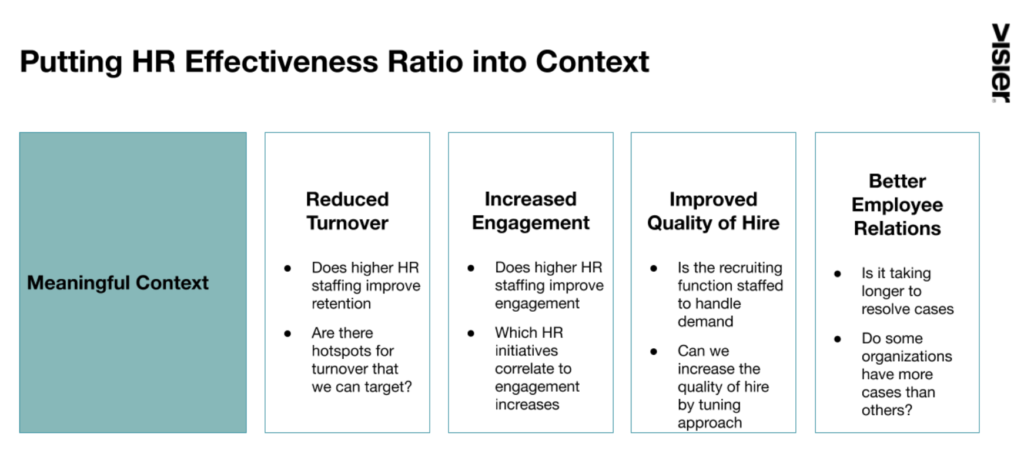How to Improve HRs Effectiveness
HR Effectiveness refers to the outcomes produced by HR activities such as employee onboarding, manager support, and so much more. Learn more.

Effectiveness. It’s on the minds of HR professionals looking to justify their budget and deliverables. HR Effectiveness, as defined by John Boudreau and Edward E. Lawler, refers to the outcomes produced by HR activities. These activities include employee onboarding, manager support, compensation planning, strategy contributions, and so much more.
As the workplace landscape evolves, business leaders struggle to strike the HR balance, often underutilizing the right HR professionals. Since its impetus, the HR-to-Employee Ratio is seen as the tried and true litmus test in HR staffing. This ratio–which has jumped from 1:100 to 1.5:100 HR professionals to employees, respectively–requires a degree of nuance to fully reap its potential benefits.
Before we unpack how to harness the power of the HR-to-Employee Ratio, let’s talk about what it is and how to calculate it.
How to calculate your HR-to-Employee Ratio
Regarded as the “well-known general rule,” the HR-to-Employee Ratio suggests 1.5 positions in human resources for every 100 full-time employees is ideal. It’s easy to understand why the ratio is attractive to organizational leaders.
Every business deals with hard numbers and facts to reach their business outcomes and this ratio provides just that. That said, business needs vary by organization and industry. A recent study by SHRM found that companies generally employ 3.4 human resource positions to every 100 employees. Does this mean that the 1.5:100 ratio is invalid? Not necessarily.
With respect to HR effectiveness and the ratio, a large component of what drives effectiveness is not about quantity, but quality. And one organization’s ratio may look vastly different from another even in the same industry. Having the right data-driven information can steer you towards the right solutions and opportunities.

The problem with being reactionary
An HR department does not look the same across organization types and industries. A tech startup with 100 employees, for example, may outsource their HR needs, while a global telecom business employing 10,000 people will deploy HR departments in their regional locations.
So to simply follow an equation positions business leaders in a reactionary position, which can make them susceptible to becoming an example of what not to do. Taking a passive approach can lead to legal ramifications, loss of top talent, and poor organizational performance. Further, a stalled HR department leads to stagnant business growth.
Well-equipped HR teams drive business outcomes. The HR function in the context of effectiveness encompasses many moving parts that require experienced people. When HR effectiveness is partnered with strategic HR business partners, businesses ignite into high-impact organizations, pushing operations into new heights.
Now, granted, not every organization can or needs a massive HR department, which begs the question, how can organizations make strategic HR decisions that drive effectiveness? Well, the answer lies in the power of data.
Harnessing data to drive HR effectiveness
People analytics enables leaders to uncover trends that influence the HR-to-Employee Ratio, decide on the appropriate interventions as a result, and also anticipate future developments based on hard evidence. With this kind of access to your data, you can:
Identify turnover hotspots in specific departments and allocate HR resources to help improve retention
Increase HR staffing when deploying new initiatives to increase engagement
Respond to and resolve HR claims quickly and efficiently with the help of data located one accessible location
Where it takes days of manual effort to pull this information from different reporting systems and put it together into spreadsheets–with little guarantee of accuracy–a people analytics platform, like Visier People®, gives you one single platform to quickly learn more about your HR team’s effectiveness. With the HR Effectiveness capability of Visier People, you can calculate and use the ratio correctly, and surface key insights on your staffing ratio, cost-per-hire, how your HCM is transforming the next generation of leaders within the organization, and much more.

Some questions Visier People helps you answer with its HR Effectiveness capabilities
With a clearer fact-based picture of HR, you can enable your team to advance from basic HR reporting to enhanced analytics that incorporate business data and people data, like PTC:
"Visier helped us get Finance and HR on the same platform and the same page, especially when talking with business leaders. Because we use the same, consistent data." -Dave Fineman, Leader of People Analytics and
Workforce Planning, PTC
People analytics gives HR leaders the ability to finally harness the power of the HR-to-Employee ratio to make the best people decisions for their organization. When you correctly leverage your people data to make better decisions, you can continuously identify and remove obstacles and plan new initiatives that will continuously give your organization a fresh advantage.
Get Outsmart content straight to your inbox
Subscribe to the People Insights Monthly newsletter for actionable insights and stories.
Subscribe now